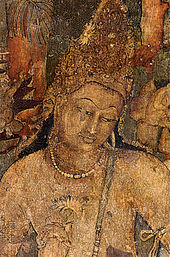Cave paintings in India

Almost all early painting in India survives in caves, as very few buildings from Ancient India survive, and though these were probably often painted, the work has been lost. The history of cave paintings in India range from drawings and paintings from prehistoric times, beginning around 30,000 BCE in the caves of Central India, typified by those at the Bhimbetka rock shelters to elaborate frescoes at sites such as the rock-cut artificial caves at Ajanta and Ellora, extending as late as the 8th - 10th century CE.
Contents[hide] |
[edit] Early medieval caves
There are known more than 20 locations around India containing murals from this period, mainly natural caves and rock-cut chambers.[1] The highest achievements of this time are the caves of Ajanta, Bagh, Sittanavasal, Armamalai Cave (Tamil Nadu), Ravan Chhaya rock shelter, Kailasanatha temple in Ellora Caves.
[edit] Ajanta frescoes
The Frescoes of Ajanta are paintings in the Ajanta Caves which are situated near Aurangabad in Maharashtra. The caves are carved out of large rocks. Inside many of the caves are frescoes.
Frescoes are paintings which are done on wet plaster in which colours become fixed as the plaster dries. The Ajanta Frescoes have a special importance of their own. They are found on the walls and ceilings at Ajanta. The paintings reflect different phases of Indian Culture from Buddha's birth to his Mahaparinirvana[2] in the 8th Century AD.
The frescoes have degraded slightly, due to the effect of flash photography. Photography here has now been banned, to prevent further degradation of the frescoes.. They depict themes of court life, feasting, processions, men and women at work, festivals, various natural scenes including animals, birds and flowers. The artists used shading to give a three-dimensional effect.
[edit] Bagh Caves
Similarly, at Bagh Caves, 150 km away to the north of Ajanta, beautiful frescoes have been found. Though the themes in these paintings are both secular and religious, they do depict some aspect of Buddhist life and rituals. One of the most famous paintings show a procession of elephants. Another depicts a dancer and women musicians. These have been influenced by Ajanta style of paintings. These frescoes show a strong resemblance to the frescoes of Sigiriya in Sri Lanka.
[edit] Notes
- ^ "Ancient and medieval Indian cave paintings - Internet encyclopedia". Wondermondo. 10 June 2010. http://www.wondermondo.com/Best/As/IndMedCavePaint.htm. Retrieved 10 June 2010.
- ^ (Mahaparinirvana was the time of Gautama Buddha's death. His disciples scattered his remains in many places, where Stupas were erected.)
[edit] References
- Total History and Civics. a history Textbook. Published by Morning Star Publishers. ICSE Std IX.
Varun Gupta
Divine Books
40/13.Shakti Nagar.
Delhi-110007.
India.
Ph.no..No..011 6519 6428
divinebooksindia@gmail.com
www.divinebooksindia.com


No comments:
Post a Comment